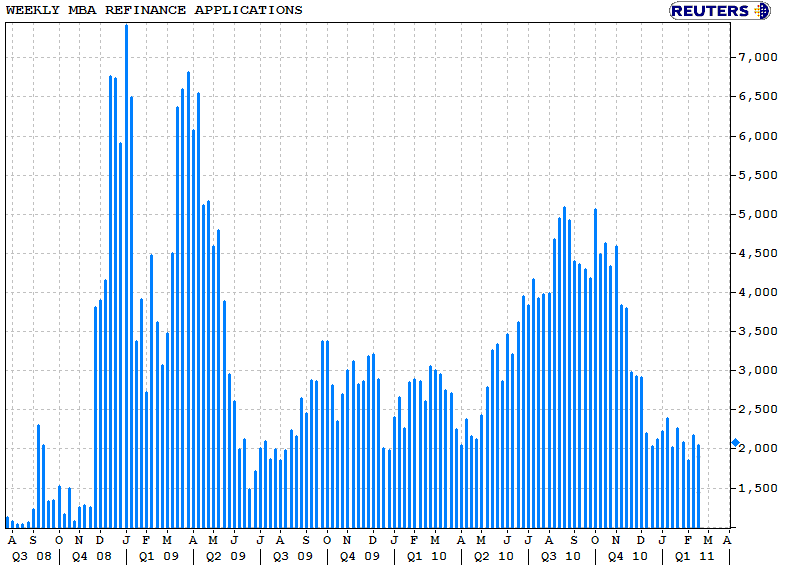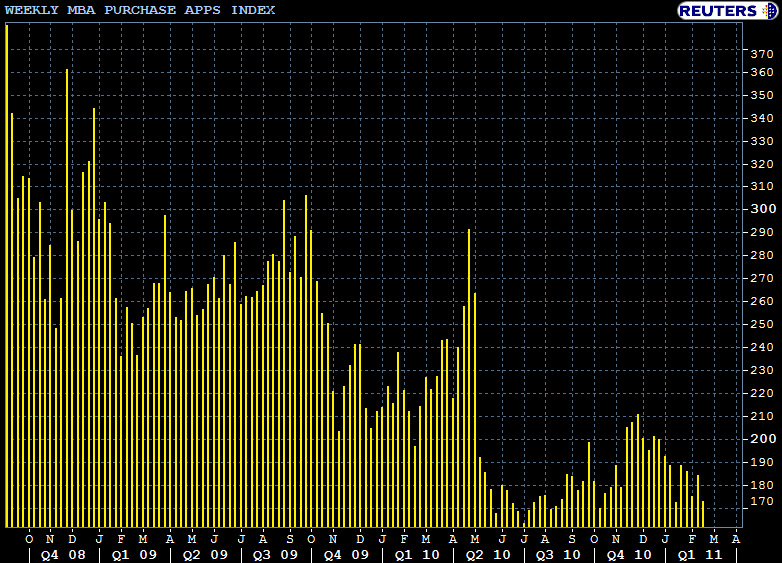The Mortgage Bankers Association (MBA) today released its Weekly Mortgage Applications Survey for the week ending February 25, 2011.
The MBA's loan application survey covers over 50% of all U.S. residential mortgage loan applications taken by mortgage bankers, commercial banks, and thrifts. The data gives economists a snapshot view of consumer demand for mortgage loans. In a falling mortgage rate environment, a trend of increasing refinance applications implies consumers are seeking out lower monthly payments. If consumers are able to reduce their monthly mortgage payment and increase disposable income through refinancing, it can be a positive for the economy as a whole (may boost consumer spending. Also allows debtors to pay down personal liabilities faster). A trend of declining purchase applications implies home buyer demand is shrinking.
Excerpts from the Release...
The Market Composite Index, a measure of mortgage loan application volume, decreased 6.5 percent on a seasonally adjusted basis from one week earlier. On an unadjusted basis, the Index decreased 5.5 percent compared with the previous week.
The Refinance Index decreased 6.5 percent from the previous week. The four week moving average is down 2.7 percent. The refinance share of mortgage activity decreased to 64.9 percent of total applications from 65.7 percent the previous week.

The seasonally adjusted Purchase Index decreased 6.1 percent from one week earlier. The unadjusted Purchase Index decreased 3.5 percent compared with the previous week and was 19.6 percent lower than the same week one year ago. The four week moving average is down 2.5 percent.

The average contract interest rate for 30-year fixed-rate mortgages decreased to 4.84 percent from 5.00 percent, with points increasing to 1.30 from 0.96 (including the origination fee) for 80 percent loan-to-value (LTV) ratio loans. This is the third consecutive weekly decrease for the 30-year contract rate. The effective rate also decreased from last week.
The average contract interest rate for 15-year fixed-rate mortgages decreased to 4.17 percent from 4.28 percent, with points increasing to 1.07 from 0.80 (including the origination fee) for 80 percent LTV loans. The effective rate also decreased from last week.

NOTE: These results do not include an adjustment for the
Presidents' Day holiday.
"A wall has been hit in loan pricing" says MND's Managing Editor Adam Quinones. "Lenders have moved the Best Execution 30-year fixed note rate as low as they possibly can without drastically altering their pipeline hedging strategies. This is a factor of what production mortgage-backed security coupon is most liquid in the secondary mortgage market. On conventional loans, the 4.50 percent MBS coupon is the hedging vehicle of choice for lock desks. Home loans with note rates between 4.875 and 5.25% are generally used to fill 4.50 percent MBS coupon trades. Until MBS investors demonstrate sustainable demand for 4.00 percent 30-year fixed MBS coupons, lenders will not find it economically efficient to quote 4.75 percent note rates without expensive permanent buydown costs. From that perspective, if you are floating a conventional home loan interest rate, you should not be expecting further improvements to your actual rate in the short term. If the bond market recovery rally continues, closing costs will improve, but on the whole, it will take a sustained move higher in 4.00 percent MBS coupon prices for Best Execution to dip below 4.875 percent."
READ MORE ABOUT MORTGAGE RATES AND BEST EXECUTION
This happened in January. HERE is a post explaining the ledge in loan pricing.







